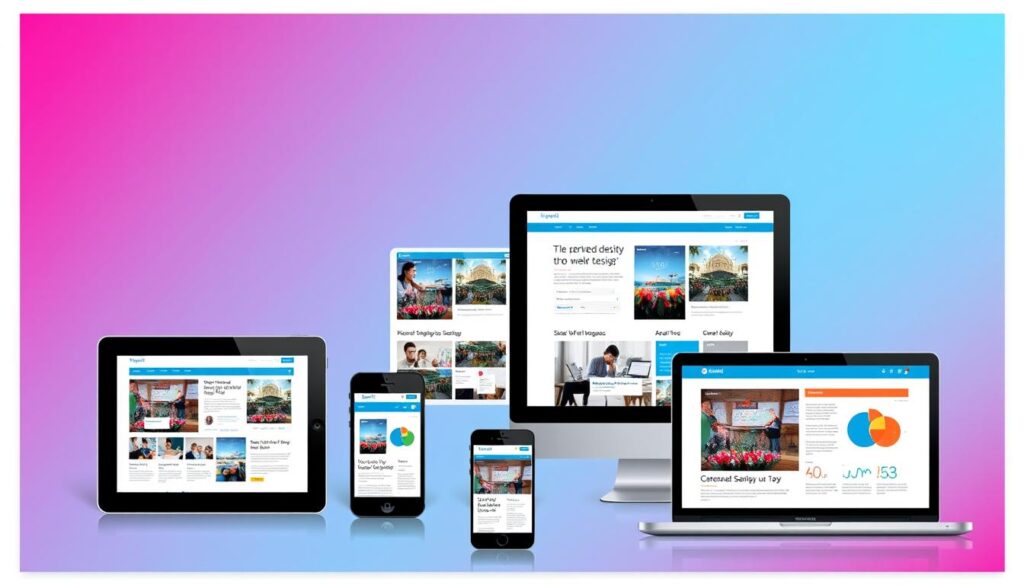Did you know that incorporating relevant images into your content can elevate engagement by up to 94%? This astonishing figure highlights the critical role of SEO for images and infographics in the contemporary digital realm. As search engines progress, *image optimization* emerges as a pivotal element of efficacious online marketing tactics. By optimizing visual content, you not only elevate your website’s discoverability but also draw in a larger audience, thereby broadening your reach. Embracing optimal image SEO practices can significantly impact your visuals’ effectiveness, ensuring they captivate both users and search engines.
Key Takeaways
- Images can significantly enhance user engagement on your website.
- SEO for images and infographics is crucial for improving website visibility.
- Effective image optimization strategies can drive more traffic to your site.
- Quality visual content is increasingly prioritized by search engines.
- Implementing best practices in visual content SEO is essential for marketers.
Understanding SEO for Images and Infographics
The optimization of visual elements is paramount in digital marketing strategies. Implementing effective SEO practices for images and infographics can significantly enhance a website’s visibility in search engine rankings. This involves the strategic use of alt tags, file names, and descriptions to increase discoverability and engagement.
What is Image SEO?
Image SEO encompasses a range of practices designed to optimize images for better visibility in search results. Central to image SEO are the use of image alt tags, which serve as text alternatives for search engines to comprehend the visual content’s context. Optimized images not only elevate search rankings but also significantly enhance user experience on the website.
Importance of Infographic SEO
Infographics have emerged as a preferred medium for presenting complex information visually. The optimization of infographics is crucial, as it enables marketers to leverage this visual content effectively. By optimizing infographics, websites can attract valuable backlinks and social shares, thereby enhancing overall site authority. Studies indicate that visual content significantly boosts engagement, making the adoption of effective infographic strategies imperative for driving traffic and improving SEO. For a deeper dive into the topic, refer to this comprehensive resource on the role of infographics in SEO: how infographics improve SEO.
The Basics of Image Optimization
Grasping the essence of image optimization is paramount for boosting website performance and optimizing visual content for search engines. The selection of image file formats is pivotal, each offering distinct benefits that influence image quality and loading speed on a website.
File Formats: JPEG vs. PNG vs. GIF
In the realm of image file formats, discerning their attributes is essential:
- JPEG excels for photographs, adeptly compressing large files to preserve quality while reducing file size.
- PNG boasts superior clarity and supports transparency, making it ideal for graphics or images necessitating a transparent background.
- GIF, renowned for its animation capabilities, is, however, limited in color depth, rendering it less ideal for high-resolution images compared to JPEG and PNG.
Understanding Image Size and Quality
The delicate balance between image size and quality is fundamental to effective optimization. Excessive image sizes can drastically impede webpage loading times, detrimental to both user experience and search engine rankings. To optimize outcomes, consider the following:
- Select image file formats judiciously, based on content requirements.
- Optimize images pre-upload by resizing them to their intended display dimensions.
- Employ compression tools to diminish file size without sacrificing quality.
Using Alt Text Effectively
Alt text is crucial for enhancing both accessibility and search engine optimization for images. It ensures images are comprehensible to screen reader users and search engines. Effective alt text implementation is vital for boosting visibility in search results, a key aspect of image SEO best practices.
Best Practices for Alt Text
Creating effective image alt tags necessitates careful thought. Adherence to the following best practices is imperative:
- Be concise: Opt for a succinct description, ideally under 125 characters.
- Be descriptive: Offer a detailed description of the image’s content or purpose, ensuring clarity.
- Use relevant keywords: Incorporate important keywords naturally, avoiding excessive repetition.
- Avoid starting with “image of” or “picture of”: Emphasize the image’s representation rather than its format.
Common Mistakes to Avoid
When optimizing alt text, it’s crucial to steer clear of common pitfalls. Here are some errors that can undermine effectiveness:
- Leaving alt text empty, which compromises accessibility for screen reader users.
- Including irrelevant information that fails to enhance the image’s understanding.
- Overstuffing keywords, which can incur penalties from search engines.
- Utilizing generic descriptions like “image” or “graphic”, which lack informative value.
Choosing the Right File Names
The selection of image file names is paramount for optimizing SEO for images. Opting for descriptive filenames significantly enhances search engine indexing capabilities, unlike default names such as DSC001.jpg, which offer minimal visibility. By adopting descriptive filenames, the likelihood of your images surfacing in pertinent search results is substantially increased.
Descriptive Filenames vs. Default Names
Employing descriptive filenames imbues context to your images, facilitating search engines in categorization and display. It is advisable to eschew generic names in favor of those that encapsulate the image’s content, such as “chocolate-chip-cookies.jpg” over the ambiguous “image1.jpg”. This method not only fosters better organization but also adheres to SEO best practices.
Keyword Placement in Filenames
Incorporating pertinent keywords into your image file names can markedly enhance SEO for images. It is beneficial to embed primary keywords that accurately depict the image, closely aligning with the page’s content. This tactic facilitates superior indexing and can contribute to elevated rankings on search engine results pages. For a deeper understanding, delve into image naming strategies that prioritize the inclusion of targeted keywords.
Image Sitemaps: What You Need to Know
Image sitemaps are indispensable for optimizing the interaction between search engines and your visual content. They facilitate the indexing of images on your site, a crucial aspect of your visual content SEO strategy. Mastery in creating and deploying image sitemaps can significantly enhance your site’s visibility, especially in Google Image searches.
How to Create an Image Sitemap
The process of creating an image sitemap is straightforward. Follow this concise guide to initiate your journey:
- Start with an XML sitemap that catalogues all URLs of your web pages.
- Within each URL entry, incorporate additional tags tailored for images.
- Include the *image location*, *caption*, *title*, and *license* for each image to offer context.
- Submit your image sitemap through Google Search Console to assist Google in discovering and indexing your visual content.
Benefits of Implementing Image Sitemaps
Image sitemaps bring several benefits that can elevate your image SEO efforts:
- They enhance the discovery of images, leading to improved indexing by search engines.
- They increase the likelihood of appearing in Google Image search results, thereby driving more traffic to your site.
- They facilitate the better organization of visual content, aiding search engines in comprehending your website’s structure and context.
Responsive Images for Better Performance

Responsive images are pivotal in enhancing the user experience across diverse devices. They dynamically adjust their dimensions and resolution to align with the screen’s specifications, ensuring optimal performance and rapid loading times. This adaptation not only enhances accessibility but also positively influences SEO rankings by reducing bounce rates.
What are Responsive Images?
Responsive images are crafted to adapt to varying screen sizes, facilitating websites in delivering visually appealing content without compromising on quality. Given the prevalence of multiple device usage, from smartphones to desktops, the necessity of responsive images cannot be overstated. Their adaptability fosters a seamless browsing experience, significantly enhancing user engagement.
Tools for Creating Responsive Images
Several tools are available for optimizing images to create responsive designs. Popular methods include:
- Utilizing the <picture> element to specify different sources for various screen sizes.
- Employing CSS media queries to modify image styles based on the viewing environment.
- Utilizing online services and software, such as Adobe Photoshop and TinyPNG, for optimizing image files while preserving quality.
By integrating these techniques, websites can maintain high loading speeds across devices, offering both superior performance and SEO advantages.
Leveraging Infographics for SEO
Infographics have emerged as a pivotal element in visual content SEO, offering a distinctive avenue for data presentation and user engagement. The creation of shareable infographics not only captivates viewers but also elevates search engine rankings. Mastery in crafting and disseminating these compelling visuals can profoundly influence your website’s online presence.
Creating Shareable Infographics
To develop infographics that foster sharing, focus on the following aspects:
- Design Quality: Invest time in a polished and eye-catching design that reflects your brand’s identity.
- Relevant Data: Include statistics and facts that provide value to your audience. Great content drives engagement.
- Clarity: Ensure that your infographics communicate information quickly and effectively. Simplicity often leads to better retention.
Infographic Promotion Strategies
Promoting your infographics enhances their reach and effectiveness. Here are some strategies to consider:
- Social Media Sharing: Utilize platforms like Instagram, Pinterest, and Facebook to share your infographics widely.
- Collaborations: Partnering with influencers can expand your reach. They can share your visual content SEO efforts with their audiences.
- Infographic Directories: Submit to infographic directories which help in building backlinks and increasing visibility.
Implementing these strategies will not only boost your infographic SEO but will also cultivate a community of engaged followers. For more ideas on effective promotion, check out this link on diet plans that also highlights content strategies.
Enhancing Website Speed with Image Optimization
The pivotal role of website speed in user satisfaction and SEO performance cannot be overstated. Image optimization emerges as a crucial factor, ensuring that visual content does not impede page loading. Employing sophisticated tools for site speed monitoring is imperative, facilitating the detection of image bloat—instances where oversized images inflate file sizes.
Tools for Testing Website Speed
For the enhancement of website speed, various analytical tools are indispensable. Notable among these are:
- Google PageSpeed Insights
- GTmetrix
- Pingdom
These instruments deliver detailed assessments, highlighting the pivotal role of image optimization in performance enhancement. They identify specific image-related bottlenecks, guiding targeted optimization strategies.
Avoiding Image Bloat
Preventing image bloat necessitates the adoption of several strategic measures. Key practices include:
- Compressing images to diminish file sizes without compromising visual quality.
- Adopting next-gen formats such as WebP, which offer superior compression capabilities compared to traditional formats.
- Limiting image dimensions to the minimum required for design purposes, thereby avoiding the use of high-resolution images unnecessarily.
Implementing these strategies ensures that images remain optimized, thereby preserving optimal website speed and enhancing the overall user experience.
The Role of Social Sharing in Image SEO

Social sharing emerges as a critical factor in augmenting image SEO and amplifying visual content visibility. In a digital realm where social media platforms reign supreme, the capacity to disseminate images and infographics profoundly influences engagement and reach. The act of sharing visually captivating content on platforms such as Instagram and Pinterest opens avenues for increased exposure. This, in turn, enhances the visibility of the content and the associated website.
Importance of Social Media for Visibility
The deployment of social media for image sharing is imperative for driving traffic to one’s website. Metrics of engagement, such as likes and shares, directly influence content ranking in search engines. Implementing effective social media strategies can introduce visual content to broader audiences. The strategic use of platforms can lead to heightened interaction, a cornerstone for image SEO.
Tips for Effective Image Sharing
To ensure the successful dissemination of images through social sharing, consider the following recommendations:
- Employ visually striking images that command attention to captivate the audience’s interest.
- Compose engaging captions that resonate with your target audience.
- Optimize images prior to posting to ensure rapid loading times.
- Integrate relevant hashtags to enhance discoverability.
- Encourage users to share your content by incorporating calls to action.
Optimizing images for social sharing can pave the way for viral content possibilities. For further insights into the confluence of social media and SEO, refer to this resource on the role of social media in.
By adhering to these strategies, individuals and brands can substantially enhance their visual content visibility. This establishes a robust online presence that propels website traffic and amplifies engagement.
Monitoring and Analyzing Image SEO Performance
The art of monitoring and analyzing image SEO performance is paramount for optimizing visual content. By meticulously tracking specific metrics, one can make strategic decisions that significantly enhance the efficacy of their image content strategy.
Key Metrics to Track
Several metrics are crucial when assessing image SEO performance:
- Organic traffic from image searches
- Click-through rates from image results
- User engagement metrics, including time spent on page
- Conversion rates from image-related actions
These metrics provide invaluable insights, guiding optimization efforts to ensure images fulfill their intended roles.
Tools for Image SEO Analysis
Employing the appropriate tools for image SEO analysis streamlines the monitoring process. Consider the following options:
- Google Analytics: An excellent resource for tracking traffic and user interactions related to your images.
- SEMrush: Offers insights into keyword rankings and performance related to your visuals.
- Ahrefs: Useful for checking backlinks and the overall performance of your image SEO strategy.
- ImageKit: Focuses on optimizing image delivery and analyzing image performance metrics.
Utilizing these tools facilitates the collection, analysis, and refinement of image SEO strategies over time.
Future Trends in Image SEO
The digital realm’s perpetual evolution underscores the imperative of staying abreast with emerging trends for efficacious image SEO methodologies. The advent of AI optimization functionalities facilitates the optimization of image management processes. Concurrently, the ascendance of visual search redefines user engagement with online content.
AI and Automated Image Optimization
Artificial intelligence is revolutionizing image SEO, with AI optimization tools now capable of automatically refining website images. This enhancement encompasses both image quality and metadata, thereby streamlining the optimization process. These automated systems scrutinize images, offering recommendations for enhancements, thereby alleviating the need for exhaustive manual intervention by marketers and content creators.
The Rise of Visual Search
The proliferation of visual search technologies has led to a paradigm shift, with users increasingly opting for image-based searches over traditional text-based queries. This necessitates a recalibration of SEO strategies. Platforms such as Google Lens serve as exemplars of this trend, enabling users to discover products and information through image uploads. Consequently, businesses must prioritize the optimization of visual content to remain relevant in this dynamic environment.
Conclusion: Making the Most of Your Visual Content
In our comprehensive examination of image SEO, it is imperative to distill the essential strategies we have dissected. The optimization of visual content transcends mere aesthetics, serving as a pivotal factor in augmenting your digital footprint. By employing optimal alt text, adopting suitable file names, and capitalizing on infographics, you can substantially elevate your standing in search engine rankings.
Adherence to best practices for image SEO is paramount for amplifying the impact of your visual assets. Engaging in social media sharing, ensuring cross-device compatibility, and scrutinizing analytics form the bedrock of success. Additionally, staying abreast of evolving visual content SEO trends can confer a competitive advantage.
Implementing these strategies will not only amplify visibility but also engender deeper audience engagement. The investment in optimizing your visuals will yield substantial dividends in your digital marketing endeavors. Embrace these image SEO best practices and witness your efforts culminate in quantifiable outcomes!
